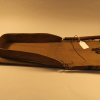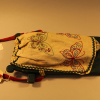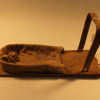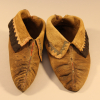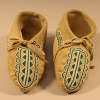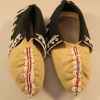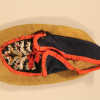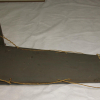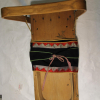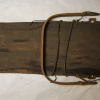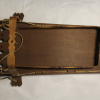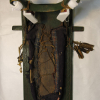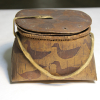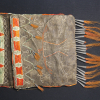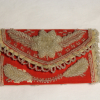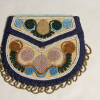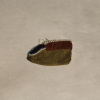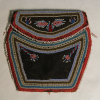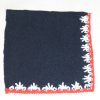Relatives/Heritage items
Displaying 1061 - 1080 of 4701 Relatives
Browsing allows you to see all the records for relatives and heritage items in the GKS. You can also search by material made, and/or filter by nations. To search by material made, type the material's name, by example 'leather', in the box below and click “Apply.” You can select multiple nations from the dropdown list by pressing “Ctrl” (on PC) or “Command” (on Mac) and clicking, then select “Apply.”
Winnebago wooden baby carrier with adjustable bow. There are bundles of metal cones and bells tied onto the bow. Made prior to 1905.
Anishinaabe (Southeastern Ojibwa) wooden cradleboard, painted and carved. Has a cotton moss bag attached with embroidery in a butterfly motif. Created prior to 1983.
Small Anishinaabe-style wooden cradleboard, probably made for a doll. Has a cloth moss bag attached. According to catalog record, this item was created circa 1875.
Hide moccasins decorated with dyed porcupine quillwork on vamps and cuffs. Attributed as either Huron or Mohawk in catalog record. Probably created in the late 18th- early 19th century. Collected by George Catilin, originally held by the Smithsonian Institution until they were exchanged with the
Pair of hide single-seamed moccasins, attributed as "Mohawk" (Kanien’kehá:ka) in catalog record. Decorated with plaited porcupine quillwork on the front and back seams, and with appliqued ribbonwork on the cuffs. Created and collected before 1867.
Pair of women's leather moccasins created by Lillian Blackchief (Seneca) of Tonawanda reservation, NY. Each moccasin is constructed out of a single piece of hide with seams on back heel and front and leather tie. There are green and white glass beads embroidered onto front
Beaded buckskin front-seam moccasins created by Lena Johnson, Seneca, of Cattaraugus Seneca reservation, NY. White and red beadwork in dome motifs cover the front seam; tree and dome motifs in white glass beads decorate the cuffs, which are made of black wool. Collected by William
Haudenosaunee beaded moccasin made of smoked hide, wool stroud, cotton tape with abstracted floral beadwork embroidered on vamp. Made prior to 1872.
Haudenosaunee carved and painted wooden cradleboard, collected by Dr. Frank G. Speck at St. Regis Mohawk reservation (Akwesasne), NY. Donated by Speck in 1947.
Anishinaabe style baby carrier made of carved wood, with a bent bow and wool wrapper with ribbon work. Made before 1960.
Haudenosaunee carved wooden cradleboard or baby carrier, made by Timothy General (member of the Cayuga nation, Six Nations reserve, Ontario) before 1944.
Carved and painted wooden baby carrier made by Chief Fred Ettawageshik (Odawa), at Harbour Springs, Michigan, before 1948. Gift of Frank G. Speck (1948)
Anishinaabe baby carrier made of carved and painted wood, with cloth bag and ornaments made of hide and animal bone. Collected by Frank Speck in 1936; donated to museum in 1948.
Anishinaabe birch bark container with lid, with geese and thistle motifs scraped into bark. Collected at Tamagami, Nipissing district, Ontario; made in 1914, purchased by museum in 1946.
Anishinaabe shot pouch made of dark tanned hide, with embroidered thunderbird and fish motifs in dyed porcupine quillwork, with metal cones and fringe made of dyed deer hair. Collected by Captain Douglas, given to museum in 1822.
Haudenosaunee beaded card case, with white glass beads embroidered onto fabric (cotton or wool) and lined with coated cotton. Floral design in raised beadwork on front and flap; back has "From Niagara Falls" written in beads. Museum acquisition: 1946
Haudenosaunee bag beaded in Seneca-style symmetrical motifs on front and back. Front has flap with hook and eye closure. Donated by Mrs. Harold J. Hayes in 1954.
Miniature front-seam moccasin with Seneca-style beaded toe/vamp. Made of deerskin with glass beads and silk trim on cuffs.
Haudenosaunee "chatelaine"-style beaded bag (Seneca style), with glass beads and silk. Collected in 1931.
Beadwork sample created by Lena Snow (Allegheny Seneca reservation, NY); purchased for the museum by Frank Speck in 1951. White and blue beadwork ("raccoon tracks" motif) embroidered directly onto navy blue wool stroud and trimmed in red silk ribbon and blue glass beads.
 Knowledge Sharing Platform
Knowledge Sharing Platform

